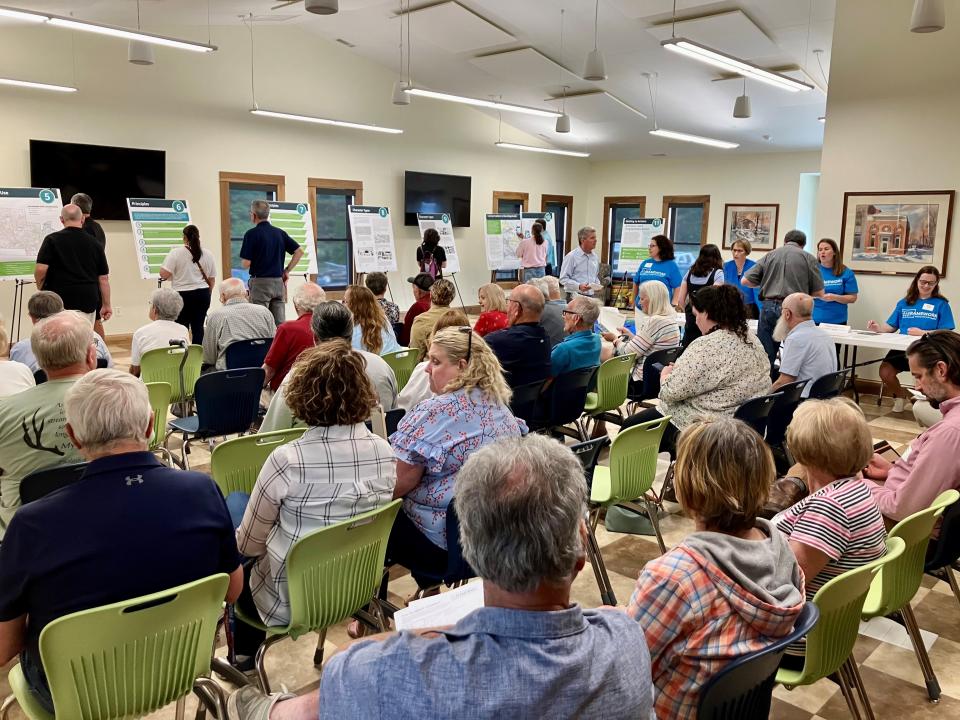Residents weigh in on Framework's plan to prepare for Intel Corporation development

JOHNSTOWN − As Licking County continues to prepare for the coming of Intel, community input into the Framework project has brought two key ideas to the forefront so far: future development needs to respect the uniqueness of each community and growth ought to take place in a way that still can preserve land for the future.
Area residents took advantage this week of one of the final opportunities to provide input to Framework, a 15-jurisdiction, public-private effort to help plan for Intel Corporation's $20 billon development near Johnstown.
More than 40 people attended the Wednesday open house at the Mary E. Babcock Library in Johnstown. The event also included a presentation from The Evans Foundation, organizer of Framework, and Planning NEXT, a planning firm based in central Ohio hired by the foundation to assist with the project.
This is part of the third and final round of public input, and it showcases everything Framework has learned so far and asks what people think. The Framework recommendations came from about 12,000 comments from 4,000 people during the first round of input.
Seven townships, four cities, three villages and county government have been part of the effort. The final Framework report is expected in August.
Jaime Greene, of Planning Next, told the audience that residents have said they don't want developments to look like every other development across the country.

“Character of place is really important to the people we’ve engaged so far," Greene said. "Folks told us that their communities are unique and authentic and when future development happens, it ought to respect that, if not reflect that. Emotional attachment to a place is foundational to prosperity.”
Another public preference is to preserve land for the future, Greene said.
“There’s also an idea that looking forward, we want to grow more inward," Greene said. "That land isn’t an infinite resource, so we should be really careful about how we’re using that in the future.”
The study area in the 15 jurisdictions covers 260 square miles, basically along the Ohio 16/37/161 corridor, north to Monroe Township and south to Pataskala. It is 38% of Licking County, but bigger than the 240 square miles of Columbus.
Greene said at the current pace, there are about 30 years left before the 260 acres are all developed.
“You’ve got a lot of land here," Greene said. "That doesn’t mean you can be insensitive to how it’s used. You have to understand what your trends are, but trends do not have to be your destiny. Modify them if they’re not meeting your vision, your aspirations.”
Sarah Wallace, chairwoman of the Evans Foundation, said the result of Framework will be a guidebook to help jurisdictions implement policies and procedures.

“It has been a remarkably fair and civil process," Wallace said. "It has really been wonderful. It has allowed elected officials to really see the pros and cons of decisions they are making.
“Decisions made in one jurisdiction can positively or negatively affect a neighboring jurisdiction. It’s learning to think differently and really be able to shape the future of Licking County.”
Franz Stein, a Johnstown resident for two years, said the success of Framework will depend on the actions of each jurisdiction.
“I appreciate the local effort to coordinate, and (have) a more comprehensive view for the whole region, so municipalities can do it on their own," Stein said. "I hope they’ll be able to use the data and public feedback to guide them.
“I'm concerned that other structures will kind of dictate the growth and direction of Johnstown. Who controls the water will control the land eventually.”
Dennis Kovach, of the Monroe Township Fire Department, attended the open house and also praised the Framework initiative.

“I think it’s admirable to try and get out in front of what western Licking County and central Licking County is facing," Kovach said. "It’s a great first step. I hope the communities take advantage of it."
In January 2022, Intel announced plans to build a $20 billion computer chip manufacturing operation just south of Johnstown on Jersey Township land since annexed into New Albany; two factories are scheduled to begin production in 2025. Development could eventually expand to $100 billion.
Intel plans to hire at least 3,000 to work at its factories, called fabs. About 7,000 construction workers will be needed, and the development could create 10,000 indirect jobs.
A second open house is scheduled for 4:30-7 p.m. Monday at the Newark branch of the Licking County Library, with a brief presentation scheduled to begin at 5 p.m. Input can also be provided online through June 16 at www.frameworklc.org and residents can virtually review content shared during the open houses.
740-973-4539
Twitter: @kmallett1958
This article originally appeared on Newark Advocate: Residents weigh in on Framework plan to prepare for Intel development

